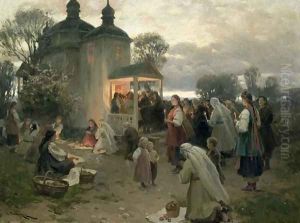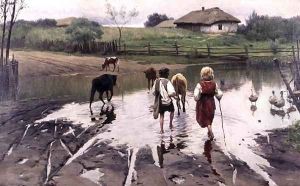Nikolai Pimonenko Paintings
Nikolai Pimonenko was a Ukrainian genre painter and a representative of the realist tradition, born on March 9, 1862, in the village of Priorka near Kyiv, then part of the Russian Empire. He showed an early talent for art, which was encouraged by his father. Pimonenko initially worked as a retoucher in a photography studio, but his passion for painting led him to pursue formal training in art. In 1880, he enrolled at the Kyiv Drawing School and later, in 1884, he continued his education at the Imperial Academy of Arts in Saint Petersburg.
During his time at the academy, Pimonenko was influenced by the works of other Russian realist painters such as Ilya Repin. He received several awards and scholarships, which allowed him to travel and study art across Europe. His paintings often depicted scenes of Ukrainian peasant life, showcasing traditional customs, festivals, and daily activities. Pimonenko's work was characterized by its detailed representation of folk costumes, interiors, and rural landscapes, as well as its empathetic portrayal of peasant life.
Pimonenko became a member of the Peredvizhniki (Wanderers), a group of Russian realist artists who sought to engage with the public through traveling exhibitions, bringing art to the people outside the academic and aristocratic circles. His works were widely exhibited and gained recognition for their contribution to the genre of folk-life painting in Ukraine and Russia.
Nikolai Pimonenko died on March 26, 1912, in Kyiv. His legacy includes a rich collection of paintings that offer insight into the cultural and social fabric of Ukraine at the turn of the 20th century. His contributions to Ukrainian art have been honored with retrospectives and continue to be studied by art historians interested in the period.

